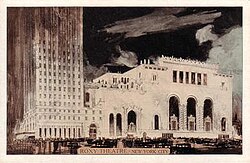Roxy Theatre (New York City)

The Roxy Theatre, 1927 postcard (the Taft Hotel is on the left)
|
|
| Address | 153 West 50th St. New York NY United States |
|---|---|
| Coordinates | 40°45′39″N 73°58′54″W / 40.760844°N 73.981783°W |
| Owner | Fox Theatres National Theaters Rockefeller Center |
| Operator | Roxy Theatre Corp. |
| Type | Movie palace |
| Capacity | 5,920 (in 1927) |
| Construction | |
| Opened | March 11, 1927 |
| Closed | March 29, 1960 |
| Demolished | 1960 |
| Years active | 1927–1960 |
| Architect | Walter W. Ahlschlager |
The Roxy Theatre was a 5,920 seat movie theater located at 153 West 50th Street between 6th and 7th Avenues, just off Times Square in New York City. It opened on March 11, 1927 with the silent film The Love of Sunya, produced by and starring Gloria Swanson. The huge movie palace was a leading Broadway film showcase through the 1950s and was also noted for its lavish stage shows. It closed and was demolished in 1960.
The Roxy Theatre was originally conceived by film producer Herbert Lubin in mid-1925 as the world's largest and finest motion picture palace. To realize his dream, Lubin brought in the successful and innovative theater operator Samuel L. Rothafel, aka "Roxy", to bring it to fruition, enticing him with a large salary, percentage of the profits, stock options and offering to name the theatre after him. It was intended to be the first of six planned Roxy Theatres in the New York area.
Roxy determined to make his theater the summit of his career and in it realize all of his theatrical design and production ideas. He worked with Chicago architect Walter W. Ahlschlager and decorator Harold Rambusch of Rambusch Decorating Company on every aspect of the theater's design and furnishings.
Roxy's lavish ideas and his many changes ran up costs dramatically. Shortly after the theater's opening, Lubin, who was $2.5 million over budget and near bankruptcy, sold his controlling interest a week before the theater opened to movie mogul and theater owner William Fox for $5 million. The final cost of the theater was $12 million. With Lubin's exit, Roxy's dreams of his own theater circuit also ended. Only one of the projected Roxy chain was built, the planned Roxy Midway Theatre on Broadway on the Upper West Side of Manhattan, also designed by Ahlschlager. The nearly complete theater was sold to Warner Bros. who opened it as Warner's Beacon in 1929.
...
Wikipedia
